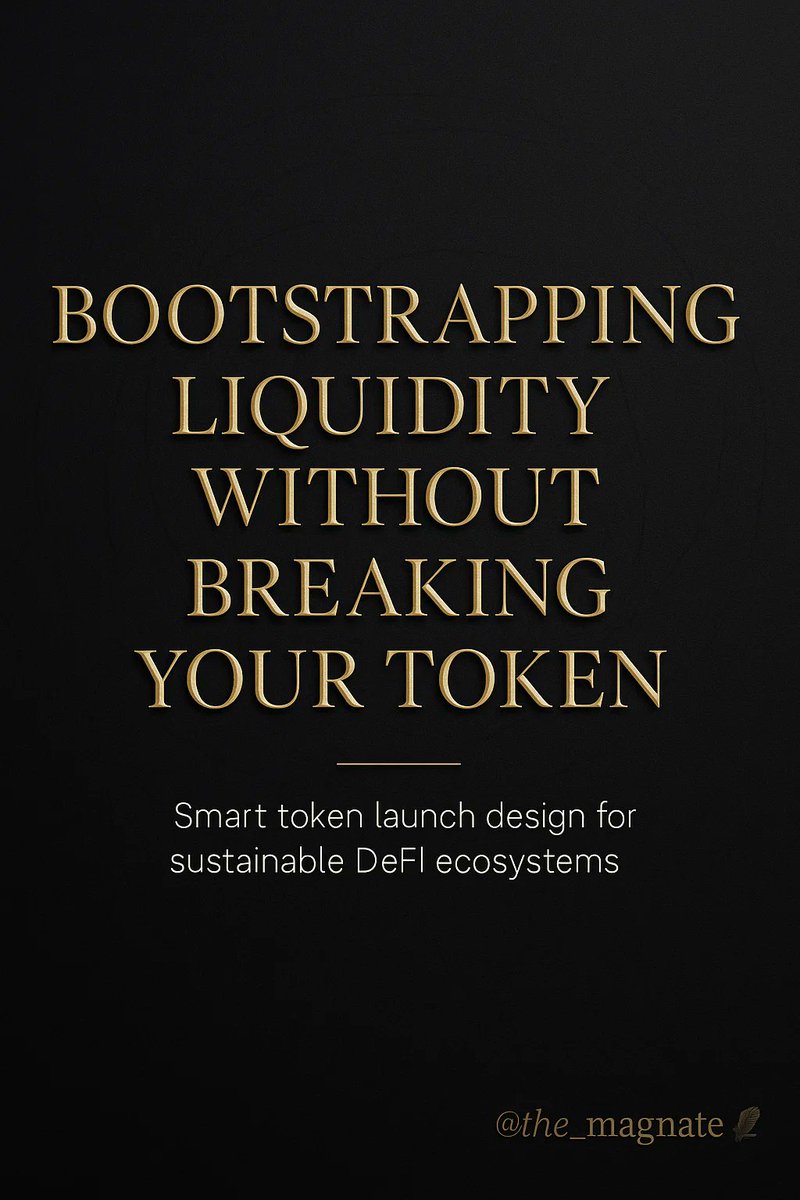How to Bootstrap Liquidity Without Destroying Token Price 🧵
1. Why This Matters 🚀
Many launch liquidity at deep discounts or via aggressive emissions. It boosts volume but often destroys early token price, deterring long-term holders. The builder-friendly goal? healthy liquidity without toxic entry.
2. Framework Overview
Four elite strategies to bootstrap liquidity while preserving price integrity:
❶ Liquidity Bootstrapping Pools (LBPs)
❷ Protocol-Owned Liquidity (POL) via Bonding
❸ Early Staking / Inflation with Exit Schedules
❹ Airdrops to Users, Not Bots
3. LBPs: Smooth Price Discovery
• Balancer LBPs allow projects to seed high initial token weights (e.g. 95/5 token/stablecoin gradually shifting to ~50/50), avoiding blind drops or bot sniping (
• Example: Crypto Unicorns raised $14.6M via LBP, price discovery occurred gradually, minimizing slippage & front-running
• Best for fair launch: deters whales, encourages measured entry & preserves reputation.
4. POL via Bonding: Own Your Liquidity
• Inspired by OlympusDAO, bonding lets protocols buy back liquidity instead of renting it via emissions (
• Liquidity becomes a permanent pool depth rather than a temporary farming yield.
• Case: projects retain treasury control over LP, aligning incentives over time.
5. Targeted Staking with Emission Exit Schedules
• Example: Synthetix (SNX) used high inflation to bootstrap early staking, then tapered emissions, shifting to fee-based yields once the protocol matured. Staking peaked early, then governance removed inflation in 2023
• Aave’s Safety Module stakes $AAVE tokens into insurance pools, earning moderate APY & contributing to protocol stability, while providing liquidity via AAVE/ETH LPs
(
6. Airdrops That Build Goodwill & Liquidity
• Properly staged airdrops attract real users, not just speculators.
• ENS’s early contributors and LayerZero’s proof-of-donation programs created stable ownership & price retention post-launch
• Multi-phase targeting: reward testnet users, builders, and long-term contributors to align with project fundamentals.
7. Common Pitfall: “Sell-Only LP” Drain
• Some token launches simply mint to bootstrap programs or faucets—then immediately sell tokens into liquidity. That adds depth, but no price support, and floods markets on release
(
• Avoid mechanical dilution that erodes price while adding no network incentive.
8. Why Builders Should Care
• Retains long-term token value → aligns with early contributors
• Attracts meaningful liquidity → not mercenary capital
• Builds aligned community → users become holders & advocates
• Navigable governance transition → as incentives fade, real utility takes over.
In Summary:
⥮ Bootstrap wrong → you bleed liquidity.
⥮ Bootstrap right → you control your market.
☑️ Incentives ≠ Ponzi fuel
☑️ Liquidity ≠ emissions
☑️ Protocols ≠ prisoners of mercenary LPs
Design liquidity like a market architect or get diluted like the rest.
💬 If you found this valuable:
• Follow @THE_MAGNATE for more elite trading frameworks.
• Bookmark 🔖 this for your trading journal.
• DM open for collabs, insights, or 1-1 Masterclass ✉️

2.58K
4
The content on this page is provided by third parties. Unless otherwise stated, OKX is not the author of the cited article(s) and does not claim any copyright in the materials. The content is provided for informational purposes only and does not represent the views of OKX. It is not intended to be an endorsement of any kind and should not be considered investment advice or a solicitation to buy or sell digital assets. To the extent generative AI is utilized to provide summaries or other information, such AI generated content may be inaccurate or inconsistent. Please read the linked article for more details and information. OKX is not responsible for content hosted on third party sites. Digital asset holdings, including stablecoins and NFTs, involve a high degree of risk and can fluctuate greatly. You should carefully consider whether trading or holding digital assets is suitable for you in light of your financial condition.

